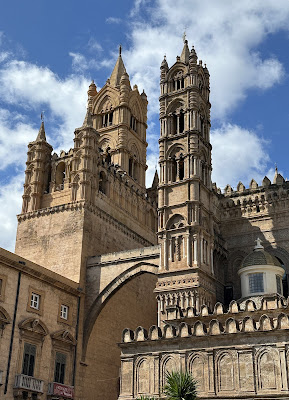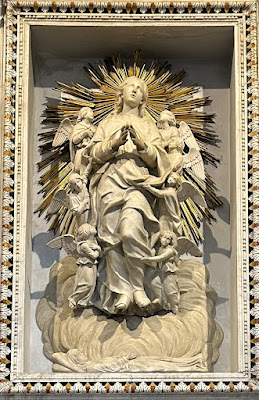March 17, 2024We lucked out in finding a parking space just a few blocks from the Monreale Cathedral, which was about a 30-minute drive from Palermo proper but still part of the metropolitan area.
I love how the neighborhoods are built up around these gems of churches in Europe, as if the church is just part of the neighborhood.
Hey, there's another one of the famous Sicilian pine cones, this one over a foot tall and a decoration at an outdoor cafe.
The Cathedral was built between 1174 and 1182 as the result of a sleepy king. William II of Sicily had fallen asleep under a carob tree near here, and in a dream the Holy Virgin told him to build a church on that spot. When the carob tree was removed so the church could be built, a cache of gold coins was found among the roots and used to finance the church. What a great story!
The official name of this church is the Chapel of San Castrense di Monreale. Saint Castrense is the patron saint of Monreale. William II was given his relic as a wedding gift, and he laid it under the high altar of the cathedral.
Like the Palatine Chapel we had just visited, the church is an amalgamation of Norman, Gothic, Renaissance, and Baroque styles. It is an earlier, larger, and somewhat lesser version of the Palatine Chapel, which was based on the design of this church. Like the Palatine Chapel, this cathedral is also a UNESCO World Heritage site.
We had to wait in line to buy tickets, but meanwhile we could enjoy the sculpture of William II of Sicily, the aforementioned sleepy king, offering his church to God.
At the other end of the entry, the Virgin Mary invites the crowds to enter (helped by Bob in the second photo):
There were the expected inlaid geometric tiles, mind-boggling in their complexity:
There was the iconographic Christ Pantocrator gazing mournfully from his spot over the altar (which was under renovation), his right hand raised in a two-fingered blessing and his left hand holding an open book. Note the number of architectural layers from front to back.
Images of saints are above the outer arch.
The ceiling, thought not quite as elaborate as the ceiling in the Palatine Chapel, is still incredible.
Like Palatine, every surface is covered with Bible stories. The work is just a little more primitive than the art in the Palatine Chapel, but still quite incredible.
The murals really serve two purposes: first, as ornamentation for the cathedral, and second, as a way of sharing the stories with those who were not literate. Here are just a few of my favorites.
I love this version of the Garden of Eden with its persuasive (and very large) serpent:
Adam and Eve are expelled from the Garden and labor to till the earth, and Abel and Cain offer their sacrifices.
Here Noah builds and loads the ark . . .
. . . and here the dove returns with an olive branch and the cargo is unloaded.
Abraham is stopped from sacrificing Isaac, and Abraham's servants meet Rebekah at the well.
We weren't there for mass, but there were plenty of relatively comfortable chairs with woven seats waiting for worshipers.
On the left below, the Baroque altar has a domed canopy and the painting on the wall behind it is of the aforementioned St. Castrense. I think the sculpture of Mary, Queen of Heaven, in her luxurious fabric clothing is especially lovely.
That looks like a pope's mitre on the ground near this kneeling figure, but which pope is it?
Below left: A bronze sculpture of John the Baptist stands under a particularly moving mosaic of John holding a scroll that reads: "Behold the Lamb of God; behold Him who takes away the sins of the World."
Below right: Jesus tied to a post for scourging, with his crown of thorns at his feet.
I'm telling you, this church does not skimp on drama!
But then, after all that heavy Christianity, what is in the courtyard outside the cathedral? None other than the Greek god Triton, wrestling with a sea serpent. Go figure.
It was about 2:00 and we hadn't eaten since breakfast, but it was Sunday and we couldn't find an open restaurant. We finally found a small shop where we ordered at the counter and they heated up some previously made lasagna and something that looked and tasted like Spaghetti-os. Not our most memorable meal.
We drove back to Palermo, hoping the cathedral was now open. It was!
Compared to the Palatine Chapel and Monreale Cathedral,
the Palermo Cathedral was positively cavernous, which is clear from the outside.
Arcades, or arches that act as supports, connect the main façade to the Archbishop's Palace.
The Palermo Cathedral is a component of the UNESCO designation that includes nine "Arab-norman Palermo and Cathedral Churches of Cefalu and Monreale." Building began in 1185, and like the other churches we'd seen earlier in the day, it is a combination of Gothic, Baroque, Norman, Byzantine, and Islamic styles due to a whole bunch of remodeling and additions over the centuries.
I was intrigued by the 20th-century sculptures on the grounds, one of Christ in agony on a circular cross and another of Pope John Paul II (apparently beloved by the avian population).
No worries, there are plenty of ancient apostles on guard as well.
Time to go inside.
Whoa, this is NOT what we were expecting. Its white, light, airy interior is dramatically different from the crowded, gilded mosaic décor of the previous two churches.

This very detailed scale model of the cathedral complex almost looks like an aerial shot of the actual place.

This is one of my favorite baptismal fonts of all time. Although I don't believe in the Catholic version of Original Sin, I do love how the font uses Adam and Eve's transgression in the Garden (complete with a serpent entwined in the tree) as the base and basis for baptism.
A second baptismal font in the cathedral is not quite as dramatic, but still very beautiful.
The Palermo Cathedral is dedicated to the Assumption of the Virgin Mary, and there are many references to her throughout.
My favorite is probably the St. Mary of the Angels Chapel with Mary surrounded by seven angels:
Below her feet are three marble panels depicting Christ washing his disciples' feet, Christ's agony in the Garden of Gethsemane, and the Last Supper.
An 18th century silver-clad Mary looks heavenward from the Chapel of the Immaculate Mary on the left, and the Altar of the Assumption is on the right:
Very typical portrayal of Mary in the style of Byzantine iconography:
Looking across the transept:
A view of the main altar with pipe organs on each side and with an ornate ceiling overhead.
One of the things I love in the Palermo Cathedral is the marble carvings of saints and apostles that are placed on the columns around the perimeter. Here we have St. Cosmas (one of a set of Arabian twins who were physicians and early Christian martyrs), St. Benedict (an Italian monk), and St. Hieronymus (aka St. Jerome, who translated the Bible into Latin).
Here are St. Sebastian (always depicted run through with arrows--the first attempt on his life that did not succeed) and my favorite, St. Christopher (who, according to legend, carried a an unknown child, who turned out to be Christ, across a river ).


This chapel, adorned with crystal chandeliers, a silver altar, and red velvet curtains and enclosed by a brass gate, is St. Rosalia's Chapel. The urn on the altar contains the relic bones of St. Rosalia, Patron Saint of Palermo.
I have no idea what this marble relief is depicting, but it is incredibly detailed.
St. Francis of Paola's Chapel pays homage to a 15th century Italian monk. I don't know who the smiling brown bust below St. Francis is.
I have come to love the Catholic Stations of the Cross, meditative works of art that guide worshipers through the passion of Christ. The Palermo Cathedral has especially beautiful marble bas reliefs of the stations. Here are a few of my favorites.
Station IV: Jesus Meets His Mother; Station VI: Veronica Wipes the Face of Jesus:
Station VII: Jesus Falls a Second Time; Station XI: Jesus Is Nailed to the Cross:
Station XII: Jesus Dies on the Cross; Station XIII: Jesus' Body is Removed from the Cross (my favorite, with the image of a grieving mother cradling her son in her arms):
People started gathering inside a little before 4:00, so we thought there must be a 4:00 mass and we hung around for a while, but when we found out that it didn't start until 5:00, we left.
We made our way to our hotel, the Airone City Hotel, and checked in. Parking was so tight that Bob finally had Stan park our car for him.
In addition to the ceramic pine cones that were everywhere, we had begun to notice ceramic heads as well, sometimes monochromatic like these that were in our hotel lobby:
We usually saw them brightly painted, looking a bit like a Halloween costume or stage make-up:
These heads are actually vases and are part of an old Sicilian legend of love and betrayal that led to a woman killing her lover out of jealousy and using his head as a vase. If you want to read the story, it can be found
here.
It would be fun to have one of these filled with the traditional basil in my garden, but the logistics of getting it home were too daunting.
Our room was not luxurious, but still nice.
We didn't want to move the car so we called a taxi to take us to dinner at a restaurant Bob had scouted out beforehand--
Divino in Gusto. The tax driver dropped us off and pointed in the direction we should walk. We had to ask directions twice to find the restaurant, which was at least three blocks from our drop off point!
The restaurant was not quite what we expected, but it was a fun place to eat nevertheless. Bob ordered sardine balls and french fries with cheese (which turned out to be crisp, hot potato chips with cheese).
Chris and Stan had pistachio pizza, and Bob and I ordered "caccamo" pizza, which had mozzarella, potatoes, sausage, and bacon toppings.
For dessert, Stan had fried dough with nutella and pistachios, Chris and I had custard with chocolate sauce, and Bob had carpaccio d'pineapple,
which was thinly sliced pineapple with lemon and basil ice cream.
We took an Uber back to the hotel rather than a taxi, and paid about the same amount as we had for the taxi.













































































(Bob) I liked the restaurant we went to, particularly the carpaccio pineapple. The pizza was also good. I was a little disappointed with the churches, the main reason we drove to Palermo. They were beautiful, but not as elegant as what I was expecting.
ReplyDelete